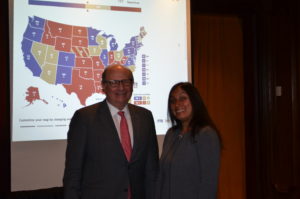Thought Leadership Series: Who Wins the White House in 2016 – and What Happens Next?
November 2nd, 2016With less than a week to go before Election Day, First Long Island Investors invited Dr. Meena Bose, Executive Dean for Public Policy and Public Service Programs in Hofstra University’s Peter S. Kalikow School of Government, Public Policy, and International Affairs, and Director of Hofstra’s Peter S. Kalikow Center for the Study of the American Presidency, to speak with clients and friends of the firm about the upcoming election.
Robert D. Rosenthal and Meena Bose in front of the electoral map
Dr. Bose began her discussion with where the Presidential race is today (as of November 2, 2016). She reminded the group that while the popular vote is important, it is the Electoral College that determines our next president. 270 electoral votes are needed to win the election – this map explains where the electoral votes are currently and which states are still considered swing states. After the release of the controversial Access Hollywood tape on October 7th, it appeared as if Hillary Clinton was clearly going to win, but the race has been tightening over the past few days as more information is hitting the media (Wikileaks, potential new FBI investigation into Hillary Clinton’s emails). Dr. Bose still believes that Clinton will win in the end. From looking at the above electoral map, you can see that all she has to do is win one or two swing states, while Donald Trump would need to almost run the table.
Dr. Bose discussed campaign strategy and touched on the differences between the Clinton and Trump campaigns as well as shared her views as to how each approach has helped or harmed their chances.
- The Clinton campaign has been mounting a strong get out the vote effort, as voter turnout for the Democrats may be an issue.
- Trump is trying to win Michigan (which she believes is out of reach) when he should be concentrating on the closer swing states such as Florida and North Carolina.
- Trump is good at coming up with slogans and statements (i.e. “Make America Great Again”, “Make America Safe Again”, “Make America Work Again”) that sum up people’s frustration with the political system, but he has little party support or public endorsements.
- Hillary is the establishment candidate with bountiful party support and endorsements, although the Democratic National Committee has come under fire for giving her more support than Sanders during the primaries.
- One of Trump’s mistakes is that he has not been able to keep the message positive. He attacks Hillary without ending on a positive note describing how he would fix problems. Bose showed this campaign ad from Bill Clinton’s 1992 campaign where he begins with a negative against Bush and then pivots to the positive and how he would make things better.
- This is a challenging election, as both candidates have their flaws and much of the country sees issues with them both. Donald Trump’s unfavorable rating is currently at 62% and Hillary Clinton’s is at 56%. These are the highest of presidential candidates when you look historically. Additionally, a recent poll showed that only 11% of voters think that Hillary Clinton is trustworthy.
A portion of the discussion focused on the primary races that led to a Clinton vs. Trump general election.
- If it had not been for the super delegates, Hillary Clinton would have had a much more difficult time securing the nomination over Bernie Sanders. This map shows how close that race was. Once the nomination was secured, the leadership in the Democratic Party focused on uniting the base, starting with Bernie Sanders at the convention.
- On the Republican side, the contest began with 17 candidates and Donald Trump ultimately had the most primary votes in history, as seen on this map. As he transitioned from the primaries to the general election, he has struggled with gaining broader support, as it is difficult without endorsements from party elites, such as previous Republican presidential candidates and presidents. Additionally, he is not getting the crossover voters that Reagan did.
During the Q&A Dr. Bose was asked if Hillary Clinton does become president, how will she move forward given potential investigations around her email server and/or the Clinton Foundation. She shared that we should expect a Hillary Clinton presidency will come with it scandal and controversy, much in the same way Bill Clinton’s presidency had. The focus on her email server situation will make it difficult for her to govern. Hopefully the country can put the past in the past, and focus on the future.
Dr. Bose was also asked if she felt that the country needed a new political party, given that the current Democratic Party is leaning so far to the left and the current Republican Party is so leaning so far to the right. She does not think a new, third party is likely, as one has never garnered significant support, due to the structure of the American political system (plurality voting and winner-take-all elections), but she agreed that we need a “new” party. She shared that it is rumored that if the Republicans lose this election, they will clean house and work to redefine the party so that they can come back very strongly in 2020.


